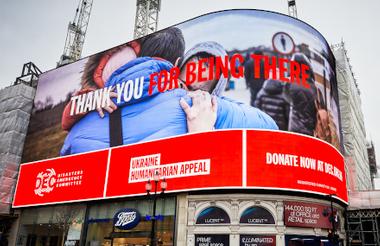Last week, the Disasters Emergency Committee’s (DEC) Ukraine fundraising appeal total reached over £400m, 11 months after it was launched.
Its total is DEC’s second highest overall, dwarfing most of the 75 other campaigns the charity umbrella group has run.
For example, the DEC Afghanistan appeal, which was launched in December 2021 in response to eight million people on the brink of famine, has raised £50m – 12.5% of Ukraine’s total. Some £10m of this was match funding from the government.
Likewise, the Pakistan floods DEC appeal launched in September 2022 raised £40m for those in the country, including £5m in match funding from the government – 10% of Ukraine’s total.
Therefore, it’s worth analysing why some fundraising appeals raise record-breaking amounts as opposed to others. What is it about the Ukraine appeal that captured the publics’ hearts and caused them to dig deep?
Consistent media coverage
Despite the Ukraine appeal having surpassed £400m, including £25m in government match funding, it is still only the second-highest total for the group – the highest belonging to DEC’s 2004 Boxing Day Tsunami appeal.
DEC’s appeal launched in response to the Indian Ocean earthquake and tsunami appeal raised £392m, which would make it £668m in today’s money. It also does not include member charities incomes, which DEC did not record at the time.
Simon Beresford, director of fundraising and marketing at DEC, says the amount of mainstream media coverage both events received significantly boosted donations to his organisation’s campaigns.
“What these two appeals share is the huge amount of space given to the topic in the mainstream media. We find that there is a correlation between broadcast and print articles and donations,” he says.
“The media and social media coverage of the Ukraine crisis means that more of us are aware of the ongoing humanitarian impact on millions of people. Individuals, corporates, communities and group from across society took action to raise awareness and raise funds.
“It remains true that the number one predictor of how large an international humanitarian emergency appeal becomes is directly correlated to how much media coverage it garners, and how long that media coverage is sustained.”
Ukraine’s crisis remains a prominent news story in British media almost a year since the Russian invasion, with president Volodymyr Zelensky meeting prime minister Rishi Sunak and addressing MPs this week.
Maryam Mohsin, head of media communications at NGO umbrella body Bond, says that consistent coverage of humanitarian aid crises is important for maintaining momentum when it comes to fundraising.
“Ukraine has dominated headlines and our TV screens for nearly a year now, and the global leadership we have seen is unprecedented. There just hasn’t been the same level of attention, or fast-acting, determined, collective leadership when it comes to other humanitarian issues,” she says.
Jess Crombie, a senior consultant for the humanitarian aid sector in communications and storytelling, agrees on the importance of media coverage.
“How much media coverage is there of a disaster and are people having conversations about what’s going on around their dinner table? Those kinds of external factors permeate into people’s minds and they become more engaged with the topic and therefore are more likely to donate or engage with it,” she says.
Marketing budgets
DEC’s Ukraine appeal has also benefitted from receiving more marketing investment than other campaigns, Beresford says.
“The DEC allocates appropriate fundraising and marketing budgets dependent on the scale of the public response we receive for any given emergency. Given its size, the Ukraine Humanitarian Appeal has been allocated our largest pre-approved appeal budget.
“This templated budget, however, ensures that our percentage costs for fundraising are kept within appropriate parameters. The appeal has also benefited from an incredible amount of pro bono and gifted media and services which have again contributed to keeping our costs low and our return on investment incredibly high.”
‘Othering’ and racial prejudice
Former Conservative Party MEP Daniel Hannan wrote in the Daily Telegraph last year about the crisis in Ukraine: “They seem so like us. That’s it. That is what makes it so shocking.”
David Sakvarelidze, former deputy prosecutor general of Ukraine received criticism for telling the BBC it was “really emotional” for him to see “European people with blue eyes and blonde hair being killed, children being killed everyday with Putin’s missiles.”
Mohsin says: “Unfortunately, if a crisis is further away, if the people affected seem different to us, or if the links between the UK and the humanitarian devastation caused elsewhere are not publicly discussed, it is much easier to look away or forget.”
Crombie says there is an element of “othering” in how charities have portrayed stories in fundraising appeals. When people find it easier to relate to those affected by a crisis, they therefore believe it does not deserve to happen to people “like them”, she says.
“What you get in a situation like Ukraine versus Pakistan or famine in the Horn of Africa, is that you are immediately removing some of the othering barriers,” says Crombie.
“To a UK audience, you’re removing largely a racial barrier as Ukrainian people are predominantly white. You’re removing a European barrier, a geographical barrier, you’re removing a socio-economic barrier in some way, though not entirely and you’re removing a kind of normative lifestyle barrier. ‘Oh, they dress like us, they shop in the same shops as us, they own mobile phones like we do’.
“There were lots of narratives like that coming out of the Ukraine conflict, which you don’t find when you look at crises in other parts of the world where those crises are somehow expected. They’re expected because we’ve told people that they should be expected - we’ve created those barriers. So that’s another massive reason why people give or don’t give [to charity appeals].”
Jon Cornejo, an anti-racism consultant from the campaign group #CharitySoWhite who has worked in aid organisations, says that the angle fundraising appeals take can often play into white saviour narratives.
“Too often charities focus their appeals on the same white and middle-class audiences and then create appeals based on the assumptions they make about those audiences. So often I’ve heard fundraisers say ‘it just works’ as an excuse or explanation as to why they are showing communities of colour in a problematic or stigmatising way.
“How are Black and brown communities meant to respond to appeals that too often cast people of colour as the helpless victim and the white aid worker as the hero? If the sector continues to pursue the same audiences and doesn’t proactively work to reach out to communities they have traditionally not reached, then we will continue to see the same dynamic at play where white saviour narratives in fundraising appeals continue because organisations assume it’s the only thing that people want to see or hear.”
Timing and transparency
Other factors can affect the success of a fundraising appeal, for example, its timing. DEC’s Pakistan floods appeal may not have raised as much as those before it due to its launch being a week before Queen Elizabeth II died, which triggered a mourning period of two weeks and dominated media coverage.
Beresford says: “Every appeal is launched at a specific moment in time and into a different context in the UK and every crisis is different in nature.”
Giving can also be triggered by personal factors. Daniel Fluskey, director of policy and communications at the Chartered Institute of Fundraising (CIOF) says giving is motivated by emotion rather than logic, making trying to pin down why some campaigns are more successful than others as “hard to do”.
“A whole range of factors are likely to be in play, including the uniqueness of the situation, the prominence of news coverage, and the fundraising appeal being felt to be part of a wider movement or campaign – for example a national effort against Covid, or a hugely significant global event that we feel in some way part of, like the war in Ukraine.”
“From an individual perspective, the closeness or connection that someone has with an event or place will be a real motivating factor. We saw that in the response to the fire at Notre-Dame, where the donations also had a very clear purpose – the money will be going to a rebuild – rather than into a situation where people aren’t sure how it’s going to be fixed.”
Therefore, transparency in how funds are going to be used and how close an issue is to home are also likely to affect how people donate.
Related articles












